-
 Fuchi-kashira of copper, carved and inlaid with gold and shakudō, with the design of Kanzan (on kashira), Chinese: Hanshan, an eccentric poet of the Tang dynasty with a scroll (618-906) who befriended Jittoku (on fuchi, Chinese: Shide, a kitchen helper at a mountain temple, holding a broom). Fuchi is signed Josui (如⽔). Fuchi (Jittoku, holding a broom): 38 x 22 x 12 mm. Weight: 23g (Nakago hole: 27 x 8.5 mm); Kashira (Kanzan, reading a scroll): 34 x 17 x 9 mm. Weight: 10g. Materials: Copper, gold, shakudō. Techniques: Tsuchi-me-ji (hammer-marked surface); usu-shishiai-bori or usuniku-bori (low-relief carving which leaves the image somewhat higher than the surface - high relief effect); zōgan (inlay). Josui was a daughter of Jochiku Kamo (Markus Sesko, Genealogies).
Fuchi-kashira of copper, carved and inlaid with gold and shakudō, with the design of Kanzan (on kashira), Chinese: Hanshan, an eccentric poet of the Tang dynasty with a scroll (618-906) who befriended Jittoku (on fuchi, Chinese: Shide, a kitchen helper at a mountain temple, holding a broom). Fuchi is signed Josui (如⽔). Fuchi (Jittoku, holding a broom): 38 x 22 x 12 mm. Weight: 23g (Nakago hole: 27 x 8.5 mm); Kashira (Kanzan, reading a scroll): 34 x 17 x 9 mm. Weight: 10g. Materials: Copper, gold, shakudō. Techniques: Tsuchi-me-ji (hammer-marked surface); usu-shishiai-bori or usuniku-bori (low-relief carving which leaves the image somewhat higher than the surface - high relief effect); zōgan (inlay). Josui was a daughter of Jochiku Kamo (Markus Sesko, Genealogies). -
 Fuchi: 38 x 22 x 14 mm. Kashira: 33 x 18 x 9 mm Techniques: Usu-shishiai-bori (薄肉合彫) – low-relief, zogan.
Fuchi: 38 x 22 x 14 mm. Kashira: 33 x 18 x 9 mm Techniques: Usu-shishiai-bori (薄肉合彫) – low-relief, zogan. -
 Fuchi: 38 x 22 x 12 mm. Kashira: 32 x 17 x 11 mm Main material: shakudo; surface treatment: nanako-ji; other metals: gold, shibuichi and copper; decorative technique: iroe takazogan. Signed: Nyudo Jounishi 人道 乗西 (possibly)
Fuchi: 38 x 22 x 12 mm. Kashira: 32 x 17 x 11 mm Main material: shakudo; surface treatment: nanako-ji; other metals: gold, shibuichi and copper; decorative technique: iroe takazogan. Signed: Nyudo Jounishi 人道 乗西 (possibly) -
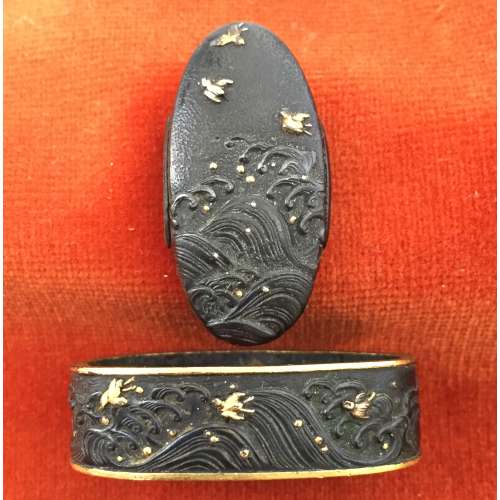 Fuchi: 37 x 21 x 11 mm; Weight: 13 g Kashira: 34 x 16 x 6 mm ; Weight: 10 g Material : Shakudo; Gold. Signature: Unsigned Technique: Sunameji Sukibori Zogan Decoration: Nami Chidori zu (wave & plover)
Fuchi: 37 x 21 x 11 mm; Weight: 13 g Kashira: 34 x 16 x 6 mm ; Weight: 10 g Material : Shakudo; Gold. Signature: Unsigned Technique: Sunameji Sukibori Zogan Decoration: Nami Chidori zu (wave & plover) -
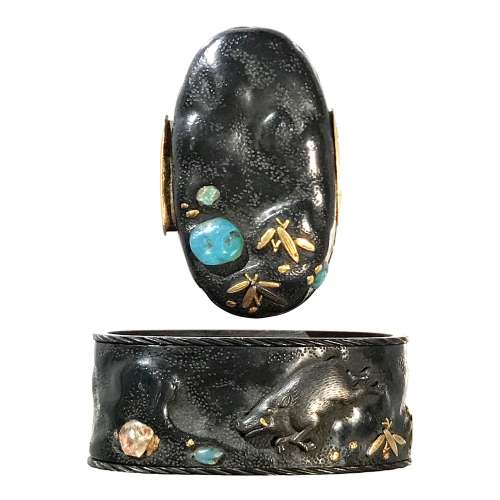 Signature: Unsigned
Signature: UnsignedFuchi-kashira with rock and boar (iwa ni inoshishi zu) motif. Inlay of precious stones or colour glass. Shakudō, gold, gemstones. Technique: Sukibori zogan kiniroe.
Fuchi: 36 x 21 x 14 mm; Weight: 22 g; Kashira: 32 x 17 x 5 mm; Weight: 8 g; Material : Shakudō; Gold; Gemstones (Chalcedony and Rose Quartz). Possibly, Owari school. -

Fuchi-kashira made of shakudō carved and inlaid with gold and red copper with the design of a bat and a fruit (persimmon?). Nanako surface.
Fuchi: 37 x 19 x 7 mm. Kashira: 34 x 16 x 5 mm. Main material: shakudō. Other metals: gold and copper. Surface treatment: nanako-ji. -
 Shakudō tsuba of the slightly vertically elongated round form (nagamaru-gata) decorated by gold in flat inlay (hira-zōgan) with three insects (cricket, locust, and praying mantis), grass and dewdrops motif. Kogai hitsu-ana is plugged with gilded soft metal. Height: 70.2 mm; width: 66.4 mm x Thickness at seppa-dai: 4.5 mm. Edo period (from ca. 1700 to ca. 1850) Unsigned. Attributed to Kaga School or Murakami School. Almost identical tsuba (no dewdrops, though) is illustrated and described at page 60 of Kokusai Tosogu Kai. 7th International Convention & Exhibition, November 1st, 2011 at Tokyo National Museum, page 60. It is attributed to the Kaga School, Mid Edo period (Late 17th - early 18th century). Dimensions: 70.5 x 66 x 4.5 mm. "The rich black shakudo plate has been slightly lowered (dished out) and then polished. Gold insects crawl amongst grasses, depicted by Kaga style hirazogan (flat inlay). One tendril of the mantis overlaps onto seppa-dai. The mantis boldly looks out from the tsuba in a curious way. This style of Kaga tsuba was popular during the Genroku era (1688-1703)."Another source is Japanese Sword Fittings. A descriptive catalogue of the Collection of G.H. Naunton, Esq., completed and illustrated by Henri L. Joly, - 1912:
Shakudō tsuba of the slightly vertically elongated round form (nagamaru-gata) decorated by gold in flat inlay (hira-zōgan) with three insects (cricket, locust, and praying mantis), grass and dewdrops motif. Kogai hitsu-ana is plugged with gilded soft metal. Height: 70.2 mm; width: 66.4 mm x Thickness at seppa-dai: 4.5 mm. Edo period (from ca. 1700 to ca. 1850) Unsigned. Attributed to Kaga School or Murakami School. Almost identical tsuba (no dewdrops, though) is illustrated and described at page 60 of Kokusai Tosogu Kai. 7th International Convention & Exhibition, November 1st, 2011 at Tokyo National Museum, page 60. It is attributed to the Kaga School, Mid Edo period (Late 17th - early 18th century). Dimensions: 70.5 x 66 x 4.5 mm. "The rich black shakudo plate has been slightly lowered (dished out) and then polished. Gold insects crawl amongst grasses, depicted by Kaga style hirazogan (flat inlay). One tendril of the mantis overlaps onto seppa-dai. The mantis boldly looks out from the tsuba in a curious way. This style of Kaga tsuba was popular during the Genroku era (1688-1703)."Another source is Japanese Sword Fittings. A descriptive catalogue of the Collection of G.H. Naunton, Esq., completed and illustrated by Henri L. Joly, - 1912:
7-U17. Ron Hartmann Collection.
Kanazawa in Kaga was a centre of fine metal work during the whole of the Tokugawa period. At first the inlayers of Fushimi following the Daimyo Maeda went to Kanazawa, then some of the Gotō masters proceeded from Kyoto for short periods to work for the Daimyo, so that their influence was strongly impressed upon Kaga work..." A somewhat look-a-like tsuba is illustrated at plate XXVIII, Kaga Inlay, №653 with the following description at page 52: "Shakudō, inlaid with five insects in gold: crickets, praying mantis, grasshopper, in the style of Takagawara Ujitsugu.
According to M. Sesko, Ujitsugu was a master from Katsuki and Kaneko School in Kaga, son of Ujihira. Ujihira's father Ujiyoshi died in 1802. This brings us to the mid-19th century, instead of mid-18th or earlier. On the other hand, a very much look alike specimen at MFA collection (ACCESSION NUMBER 17.1061) has the with the following description: Edo period. Late 18th–early 19th century. Murakami School. Main material: shakudo; other metals: gold; decorative technique: iroe hirazogan.A detailed account of Murakami school can be found at The Japanese toso-kinko Schools.// Lulu Inc., 2012 by Markus Sesko, on pages 235-239. All-in-all, it's either Kaga School or Murakami School, either ca. 1700 or ca. 1850. Quite a range! SOLD
MFA # 17.1061
-
 Copper (suaka) tsuba of oval form carved in relief, pierced and inlaid with soft metals (gold, shakudō, shibuichi or silver) with a cormorant fisherman (ushō) and moon motif on the face and a boat among the bank reeds on the reverse. Signed: Nagatsune. Box inscription: Tsuba with cormorant fishing, made by Nagatsune. Dimensions: 62.7 mm x 53.2 mm x 4.2 mm (at seppa-dai) Edo period: 18th century. Nagatsune (1721-1787), 1st generation master of Inchinomiya School in Kyoto, adopted son of the gilder Nagayoshi, student of Yasui Takanaga [M. Sesko 'Genealogies', p. 26]. Detailed account of the school is given at The Japanese toso-kinko Schools.// Lulu Inc., 2012 by Markus Sesko, pp. 104-108. Nagatsune's biographical sketch can be found there on pp. 104-106. "What Sōminis in the East (Edo), Nagatsune is in the West (Kyōto)." “Since Nara period, Japanese fishermen in small boats have used cormorants (u) to catch river fish at night, binding the necks of the birds so that the fish are not swallowed. […] The bird and the work it performs are symbols of selfless devotion to one’s master and keen eyesight.” – from Merrily Baird 'Symbols of Japan. Thematic motifs in art and design.' //Rizzoli international publications, Inc., 2001; p. 104. See also in this collection: TSU-241 and TSU-0096
Copper (suaka) tsuba of oval form carved in relief, pierced and inlaid with soft metals (gold, shakudō, shibuichi or silver) with a cormorant fisherman (ushō) and moon motif on the face and a boat among the bank reeds on the reverse. Signed: Nagatsune. Box inscription: Tsuba with cormorant fishing, made by Nagatsune. Dimensions: 62.7 mm x 53.2 mm x 4.2 mm (at seppa-dai) Edo period: 18th century. Nagatsune (1721-1787), 1st generation master of Inchinomiya School in Kyoto, adopted son of the gilder Nagayoshi, student of Yasui Takanaga [M. Sesko 'Genealogies', p. 26]. Detailed account of the school is given at The Japanese toso-kinko Schools.// Lulu Inc., 2012 by Markus Sesko, pp. 104-108. Nagatsune's biographical sketch can be found there on pp. 104-106. "What Sōminis in the East (Edo), Nagatsune is in the West (Kyōto)." “Since Nara period, Japanese fishermen in small boats have used cormorants (u) to catch river fish at night, binding the necks of the birds so that the fish are not swallowed. […] The bird and the work it performs are symbols of selfless devotion to one’s master and keen eyesight.” – from Merrily Baird 'Symbols of Japan. Thematic motifs in art and design.' //Rizzoli international publications, Inc., 2001; p. 104. See also in this collection: TSU-241 and TSU-0096The design was popular among the tsuba makers. We find one in the Alexander G. Moslé collection [Japanese Sword Fittings from the Alexander G. Moslé Collection; Sebastian Izzard LLC, 2004, page 90, №123] signed Nagatsune with kaō: Tsuba with cormorant fisherman, moon, and boat. Squared-oval shibuichi plate, slightly raised rim, engraved, pierced, and inlaid with soft metals in relief. 6.7 x 5.8 cm.

Alexander G. Moslé collection №123.
Another reference: Lundgren Collection, 1990, page 86 №207: Sword guard with design of ushō (person who fishes with cormorants). Signed by Nagatsune. Ichinomiya school. 6.45 x 5.95 x 0.40 cm. Polished shibuichi taka-bori relief, gold and silver inlay. Edo period, 18th century.

Lundgren Collection №207:
-
 Mokkō form iron tsuba carved in relief and inlaid with soft metals (copper, gold, silver) with the design of a cormorant fisherman on the face and a boat on the reverse. Unsigned. Dimensions: 77 mm x 69 mm x 3.0 mm (at seppa-dai) Edo period: 18th or 19th century. "Since Nara period, Japanese fishermen in small boats have used cormorants (u) to catch river fish at night, binding the necks of the birds so that the fish are not swallowed. [...] The bird and the work it performs are symbols of selfless devotion to one's master and keen eyesight." - from Merrily Baird. Symbols of Japan. Thematic motifs in art and design. Rizzoli international publications, Inc., 2001; p. 104. See also in this collection TSU-0212 and TSU-0241.
Mokkō form iron tsuba carved in relief and inlaid with soft metals (copper, gold, silver) with the design of a cormorant fisherman on the face and a boat on the reverse. Unsigned. Dimensions: 77 mm x 69 mm x 3.0 mm (at seppa-dai) Edo period: 18th or 19th century. "Since Nara period, Japanese fishermen in small boats have used cormorants (u) to catch river fish at night, binding the necks of the birds so that the fish are not swallowed. [...] The bird and the work it performs are symbols of selfless devotion to one's master and keen eyesight." - from Merrily Baird. Symbols of Japan. Thematic motifs in art and design. Rizzoli international publications, Inc., 2001; p. 104. See also in this collection TSU-0212 and TSU-0241. -
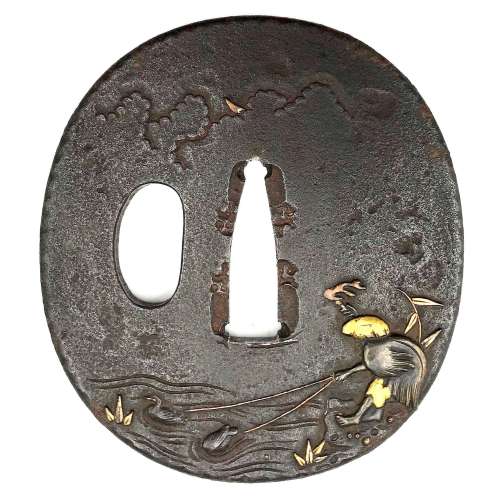 Iron tsuba of oval form carved and inlaid in gold and copper with cormorant fisherman in disguise. Unsigned. Dimensions: 67.7 mm x 61.5 mm x 3.8 mm (at seppa-dai) Edo period: 18th century. "Since Nara period, Japanese fishermen in small boats have used cormorants (u) to catch river fish at night, binding the necks of the birds so that the fish are not swallowed. [...] The bird and the work it performs are symbols of selfless devotion to one's master and keen eyesight." - from Merrily Baird. Symbols of Japan. Thematic motifs in art and design. Rizzoli international publications, Inc., 2001; p. 104. See also TSU-0212 and TSU-0096
Iron tsuba of oval form carved and inlaid in gold and copper with cormorant fisherman in disguise. Unsigned. Dimensions: 67.7 mm x 61.5 mm x 3.8 mm (at seppa-dai) Edo period: 18th century. "Since Nara period, Japanese fishermen in small boats have used cormorants (u) to catch river fish at night, binding the necks of the birds so that the fish are not swallowed. [...] The bird and the work it performs are symbols of selfless devotion to one's master and keen eyesight." - from Merrily Baird. Symbols of Japan. Thematic motifs in art and design. Rizzoli international publications, Inc., 2001; p. 104. See also TSU-0212 and TSU-0096 -
 Kozuka with seven insects (fly, grasshopper, bee, butterfly, dragonfly, firefly, and cricket) and grass with dewdrops motif. Shakudō, flush gold inlay (hira-zōgan). 95.2 (H) x 13.7 mm (W). Mid Edo period (Late 17th - early 18th century, Genroku era 1688-1703). Unsigned. Kaga school. A look-a-like kozuka (with five insects) is illustrated at Japanese Sword Fittings. A descriptive catalogue of the Collection of G.H. Naunton, Esq., completed and illustrated by Henri L. Joly, - 1912 on plate XXIX, №691 [LIB-1389 in this Collection] with the following description at page 54: "Shakudō, inlaid with butterfly, dragon-fly, grasshopper, locust and another insect, gold."
Kozuka with seven insects (fly, grasshopper, bee, butterfly, dragonfly, firefly, and cricket) and grass with dewdrops motif. Shakudō, flush gold inlay (hira-zōgan). 95.2 (H) x 13.7 mm (W). Mid Edo period (Late 17th - early 18th century, Genroku era 1688-1703). Unsigned. Kaga school. A look-a-like kozuka (with five insects) is illustrated at Japanese Sword Fittings. A descriptive catalogue of the Collection of G.H. Naunton, Esq., completed and illustrated by Henri L. Joly, - 1912 on plate XXIX, №691 [LIB-1389 in this Collection] with the following description at page 54: "Shakudō, inlaid with butterfly, dragon-fly, grasshopper, locust and another insect, gold." See also tsuba TSU-0211 in this collection:
See also tsuba TSU-0211 in this collection:


-

An iron tsuba of slightly vertically elongated circular form carved and pierced with a mass of ivy (tsuta) leaves and tendrils, details damascened with gold in nunome-zōgan technique. Hitsu-ana with raised rim.
Unsigned.
Chōshū school.Height: 72.0 mm; width: 69.0 mm; thickness: 4.7 mm; Weight: 92 g.
According to John W. Dower, "ivy bears fairly close resemblance to both maple leaf and grape leaf". However, I consider this tsuba decorated with ivy leaves for several reasons, such as the lack of racemations in the presence of tendrils. -
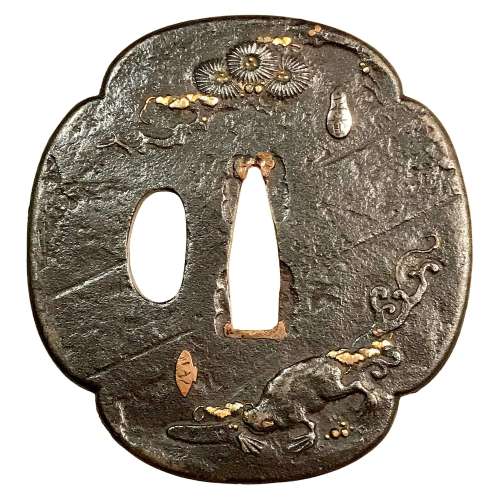
Iron tsuba of mokkō-form with a pine and a frog on the face and a snail on the back, carved and inlaid with gold. Each figurative element of the design is signed on three inlaid cartouches: Masaharu (正春), Kazuyuki (一之), and Yoshikazu (良一) [read by Markus Sesko]. Snake, snail, and frog together make a design called "SANSUKUMI" - Three Cringing Ones [Merrily Baird]. The snail can poison the snake, the frog eats the snail, and the snake eats the frog. It's unclear whether the pine replaces the snake on this tsuba, or the snake is hiding in the pine? Anyway, the frog and the snail are clearly represented. "Maybe we have here a joint work with Masaharu (the silver cartouche next to the pine) being the master and making the plate and Kazuyuki and Yoshikazu as his students carving out the frog and the snail respectively". Copper sekigane.
Dimensions: 70.9 x 67.2 x 3.0 mm. Edo period (18th century).Markus Sesko writes: "I agree, the frog and the snail most likely allude to the san-sukumi motif. It is possible that we have here an artist's choice to deliberately leave out the snake, maybe he thought that the motif is already obvious and there is no need to add a snake to make it clear that the tsuba shows the san-sukumi motif." [Markus Sesko].
Kazuyuki (一之): adopted son of Kumagai Yoshiyuki, student of Ichijō (Gotō-Ichijō Scool) [M. Sesko 'Genealogies', page 19.] Masaharu (正春): Kasuya fam., student of Masamichi (1707-1757) who was the 4th generation Nomura School master in Edo. [M. Sesko 'Genealogies', page 49.] -
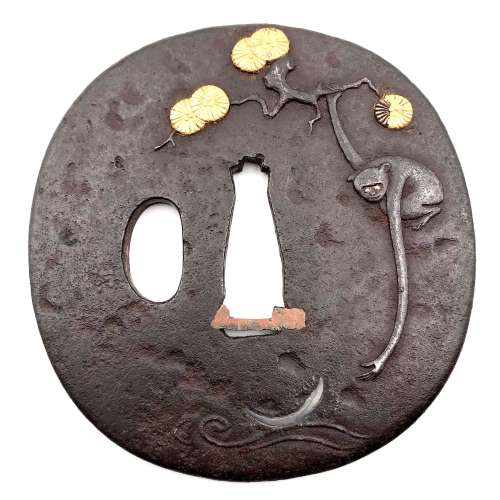 [SOLD]
[SOLD]Iron tsuba of slightly elongated round form carved and inlaid in gold and shibuichi with a long-armed monkey hanging from a pine tree branch reaching for the reflection of a crescent moon in the stream. A pine tree carved with details inlaid in gold on the reverse. The design seems to be inspired by Kaneie work (Compton III, p. 10, №6a; Tsuba no bi, 1947, p. 33, №56).
Dimensions: 76.8 x 74.2 x 3.6 mm. Mid-Edo period. Unsigned.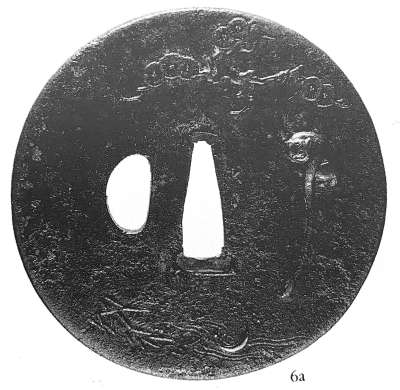
Compton III, p. 10, №6a

Tsuba no bi, 1947, p. 33, №56.
-

Bronze tsuba of mokkō form with narrow slightly raised rim carved in kebori with the sea weed and inlaid with a lobster (ebi) made of copper on the face and two sea shells made of shakudo on the back. Lobster's antennae inlaid in gold, and eyes inlaid in shakudo. Ishime-ji treated surface.
Unsigned.
Late Edo period (mid-19th century). Dimensions: 76.3 x 71.1 x 3.7 mm -

A copper tsuba with ishime-ji ground carved and polished (migaki-ji) with sitting Daruma; his eyes are inlaid with shakudo and he has a golden earring. The reverse carved with four characters: 廓 然 無 性 (Kakunen-mushō). It is a Zen proverb that goes back to Bodhidharma (Daruma), meaning "boundless expanse and nothing that can be called holy." [Markus Sesko translation]. Shakudo fukurin.
Unsigned.
Edo period (circa 1800). Dimensions: 68.2 x 65.5 x 4.8 (center) x 3.2 (rim) mm -
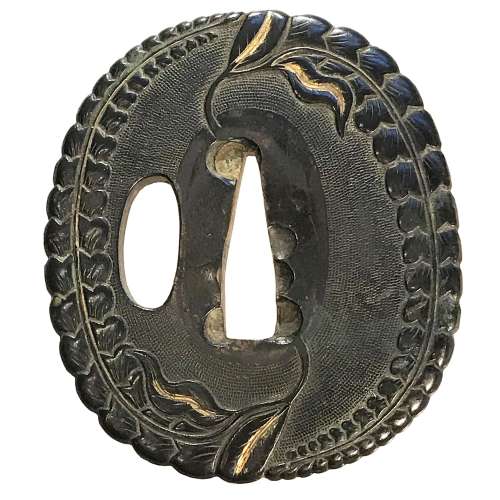
A yamagane tsuba of oval form with green-ish black patina decorated in usuniku-bori carving and gold iroe with wisteria (fuji) motif plus nanako-ji ground on both sides. Kozuka-hitsu-ana possibly cut later.
Unsigned.
Momoyama or may be even Muromachi period. Dimensions: 70.0 x 61.2 x 5.0 (center) mm -
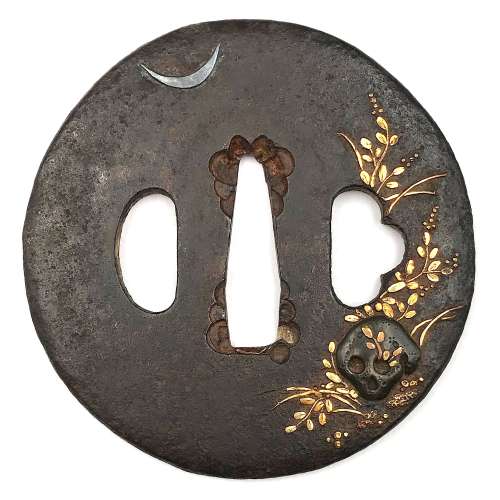 An iron tsuba of round shape inlaid with shakudō, gold, and silver with a motif of a weather-beaten (nozarashi) skull and grasses growing beside as well as through the eye-pit, and a crescent moon above the scene. Grasses on the reverse. Unsigned. Dimensions: 71.7 x 70.6 x 4.2 mm Reference: Skull, bones and grave markers SOLD
An iron tsuba of round shape inlaid with shakudō, gold, and silver with a motif of a weather-beaten (nozarashi) skull and grasses growing beside as well as through the eye-pit, and a crescent moon above the scene. Grasses on the reverse. Unsigned. Dimensions: 71.7 x 70.6 x 4.2 mm Reference: Skull, bones and grave markers SOLD


